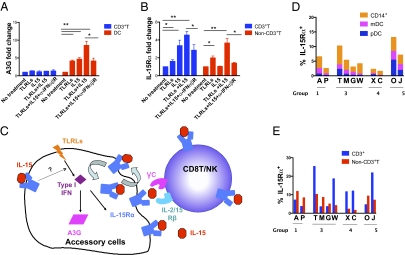Fig. 4.
Mechanisms of the synergistic effects of TLR agonists and IL-15 to induce cellular and innate immunity. Healthy macaque PBMCs were treated with TLR agonists or IL-15 for 3 days and A3G+ (A) and IL-15Rα+ (B) cell populations were measured by eight-color ICS/surface assays. Monoclonal antibody blocking human IFNα/β receptor chain 2 (50 μg/mL) was used to pretreat the cells for 30 min before TLR agonists and IL-15 were added. Results are representative of at least three independent experiments. (C) The proposed synergy model for TLR agonists and IL-15 to induce cellular and innate immunity. Upon the stimulation of TLR agonists, accessory cells were induced to express type I IFN, which then up-regulates A3G and IL-15Rα expression. As a consequence, surface IL-15Rα binds IL-15, which was provided with vaccine, and delivers an IL-15 signal to neighboring T cells/NK cells through transpresentation. In addition, the IL-15/IL-15Rα complex on the cell surface contributes to the long survival of CD8 memory T cells via recycling of the complex. IL-15 might synergize with TLR agonists to induce A3G and IL-15Rα. (D and E) Different IL-15Rα+ cell populations (Methods) were measured by surface staining in the MLNs of representative animals from different immunization groups. Data show mean and SEM.

